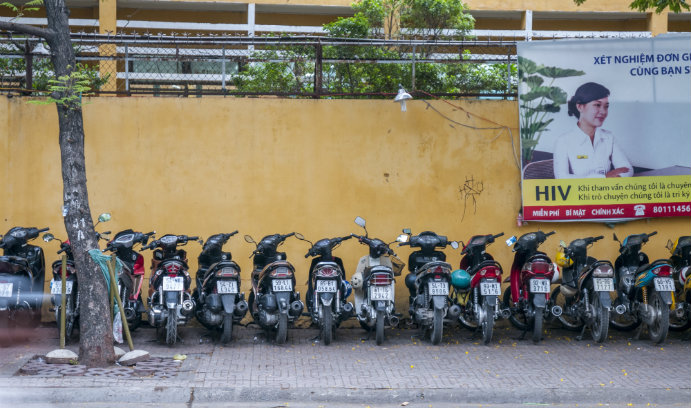Study: Role of Unemployment in Predicting Female HIV Rate

Kelly Austin, associate professor of sociology, publishes study on 'Trading Sex for Security: Unemployment and the Unequal HIV Burden Among Young Women in Developing Nations.' Above, a row of motorcycles are parked near an HIV awareness poster in Vietnam. Credit:tbradford
Kelly Austin, an assistant professor of sociology at Lehigh, finds in the first research paper to consider the role of unemployment in predicting the female HIV rate, that unemployment among young women significantly impacts the proportion of female HIV cases among those aged 15-24 in developing, especially Sub-Saharan African, countries.
Results of the study, “Trading Sex for Security: Unemployment and the Unequal HIV Burden Among Young Women in Developing Nations,” published in International Sociology, links poverty and unemployment among young women to transactional sex with older men who, while being more economically able to provide for them, are much more likely to be HIV positive than their younger male counterparts.
Due to a lack of access to formal employment options, there is an increased likelihood of concurrent partners, transactional sex, and "sugar daddies" among young women who are unemployed, according to the study.
Austin says that engaging in transactional sex (non-marital, non-commercial sexual relationships where money and gifts are exchanged) to make money, obtain food, clothes or other necessities is thought by these women to fulfill their feminine roles as family providers and caretakers.
“Other research also shows that young women may enter into these relationships to fund needs of a ‘modern’ young woman, like cosmetics or sanitary pads,” she adds.
In addition, economically disempowered women in less-developed nations often become victims of sex trafficking, leading to heightened chances of HIV. “Women who are looking for work can be tricked by being promised a job with steady income,” writes Austin in the study, “only to be trafficked and prostituted by powerful, manipulative, or well-connected individuals.”
In the research, comparative analyses were performed, examining patterns in young women's unemployment rates on the proportion of female-to-male HIV cases for 15-24 year olds.
Austin writes, “The direct link between unemployment and the HIV/AIDS burden among young women in less-developed countries is underexplored in the current literature and deserves empirical scrutiny.”
HIV prevalence is higher among sex workers and prostitutes, the study says, and it may be rampant among sex workers in Asia and sub-saharan Africa.
Another finding from the study, according to Austin, is that young women’s employment did not reduce their risks of contracting HIV. Thus, employment is not a “silver bullet” either, and this finding may speak to the very low-paying jobs that young women have access to in less-developed nations.
In light of these findings, Austin concludes that, “targeted interventions at young women focused on the logic of partner choice may be a useful strategy. Demonstrating to young girls how their likelihood for contracting HIV increases with the age of their sexual partners may be more relevant and effective than traditional ‘ABC’ or abstinence and condom messages common to current public health outreach on HIV/AIDS.”
Posted on:




